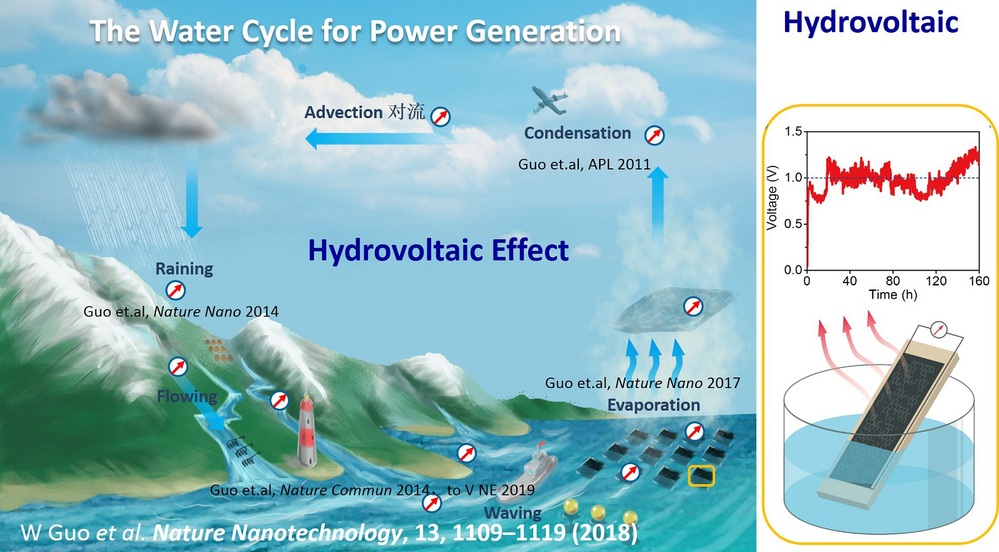The hydrovoltaic effect is a physical effect that directly converts the mechanical energy (raindrops, rivers, waves) and environmental thermal energy contained in water into electrical energy through the interaction of water and materials. Water is the source of life, and electricity is the foundation of modern technology. Replacing primary energy and achieving carbon neutrality is the goal of my country's sustainable development in the next 30 to 40 years. The most abundant energy source on earth is the thermal energy that exists around us and in the atmosphere, from the sun, through water evaporation, condensation, rainfall, rivers, lakes, driving the earth's water cycle and maintaining the earth's freshwater resources. The interfacial physics and mechanics processes behind the hydroelectric effect involve multiple levels from micro to macro, including new green energy, surface interface physics, water-related ecology, biophysics, complex system science, cross-scale theory and calculation, and hydroelectric effect material design preparation, etc. While generating electricity, hydrovoltaic materials can also promote the process of evaporative cooling and the generation of purified water, which is a new way to simultaneously alleviate major human problems such as electricity demand, global warming challenges and lack of drinking water.

The characteristics of Three Aviation are the traditional advantages and main line of development of the school. With the emergence of new technologies and new applications, great changes have taken place in the field of Three Aviation . Especially in the context of competition among major powers, China's research and development of future aerospace equipment is urgent and strong. It is not only necessary to narrow the gap and strive for upstream in the existing mainstream technology directions, but also attach great importance to emerging cross-cutting research and seize development opportunities.
Faced with the severe situation of aerospace products with increasingly complex demands, tighter delivery deadlines, and increasingly heavier tasks, the aerospace and defense industries must undergo data transformation to achieve fundamental innovation. Stay competitive in a tough environment of lower costs, higher standards, better performance and greater capacity. my country has gradually attached importance to aerospace digital engineering and invested a lot of research and development funds. However, the digital design tools used in my country's aerospace industry still rely heavily on Western countries. In the international competition of next-generation aerospace equipment, planning the layout in advance and developing advanced design theories and digital/intelligent design tools is a feasible way to achieve overtaking on curves and avoid being controlled by others.
The Frontier Institute will face the future development trend of aerospace vehicles and power, explore and sort out several key research issues that cross disciplines, implement goal orientation, give full play to the school's existing discipline advantages, and combine the country's layout to increase aerospace equipment innovation (such as JKW Innovation Bureau, the two aircraft special projects, the National Natural Science Foundation of China Interdisciplinary Science Department, etc.), focusing on research on digital aircraft, digital engines, new unmanned aerial vehicles, and intelligent technologies for deep space exploration spacecraft. The Frontier Institute will aim at the bottleneck, subversive, and forward-looking research directions in aerospace dataization and intelligent technology, and carry out research work on three platforms: the aerospace CGRO platform, the aerospace digital twin platform, and the deep space exploration intelligent technology platform. . Build a scientific research team focusing on cutting-edge cross-directions such as new concept aerospace vehicle and power system technology, new methods and new theories of aerospace scientific issues, and help the high-quality development of our school's aerospace science and technology talent team.

Research on materials plays a major supporting role in major national strategies, national economic development and scientific frontier research. From the age of stone, bronze, iron to steel, the development of human civilization and society is accompanied by the history of the development of advanced materials. In the 20th century, the emergence of polymer materials represented by polyethylene, polytetrafluoroethylene, synthetic rubber, etc., as well as various high-performance metals, ceramic materials, and composite materials, contributed to the rapid development of aerospace technology and people's livelihood economy. In particular, the emergence of transistors has made semiconductor materials shine, and the continuation of Moore's Law has led to the explosive development of the semiconductor industry and created the entire information age. In the 21st century, the material discipline has developed in-depth and extended horizontally, and has undergone deep cross-integration with physics, chemistry, medicine, mathematics and other disciplines, opening up new research directions such as soft matter, nanomaterials, and biomimetic materials. Advanced material science and device technology are developing in the direction of the intelligent era. The research of materials is not only the basis for leading international frontier scientific research (Dingtian), but also the key to solving the stuck neck technology (site).
With the development of materials towards functionalization and intelligence and the integration of advanced materials and devices, the discipline of materials has begun to interpenetrate and expand with multiple disciplines such as chemical engineering and technology, physics, mechanical engineering, and mechanics. At present, the School of Materials Science and Technology of our school has three major disciplines: materials science and engineering, applied chemistry, and nuclear engineering, and has carried out rich research in the fields of electrochemical energy storage, nuclear energy technology, and metal processing. However, advanced materials science and device research is different from the current development direction of the School of Materials Science and Technology, and has a high degree of cutting-edge and cross-cutting attributes, especially the integration of the frontiers of physics, mechanics and mechanical manufacturing.
Institute for Frontier Science will focus on cutting-edge material science issues and national defense needs, develop advanced materials and devices with high-efficiency environmental response, drive, and adaptability, and solve material problems in frontier fields such as hydroelectric energy, smart sensing, and advanced manufacturing. Develop preparation, performance characterization, and measurement and control technologies for advanced materials and devices, build new principles and new methods for nano-smart devices, and explore the transition from basic research to engineering technology for advanced materials. In the initial stage, it is planned to build three platforms, namely the controllable preparation and qualitative and quantitative processing platform of intelligent materials, material characterization, device performance testing and service evaluation platform, and micro-nano composite structure manufacturing platform, so as to attract and cultivate innovative talents in the field of advanced materials and intelligent devices in the future. To build a high-level cutting-edge interdisciplinary research base with innovative characteristics.
